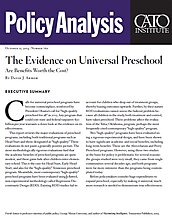Calls for universal preschool programs have become commonplace, reinforced by President Obama’s call for “high-quality preschool for all” in 2013. Any program that could cost state and federal taxpayers $50 billion per year warrants a closer look at the evidence on its effectiveness.
This report reviews the major evaluations of preschool programs, including both traditional programs such as Head Start and those designated as “high quality.” These evaluations do not paint a generally positive picture. The most methodologically rigorous evaluations find that the academic benefits of preschool programs are quite modest, and these gains fade after children enter elementary school. This is the case for Head Start, Early Head Start, and also for the “high-quality” Tennessee preschool program. Meanwhile, most contemporary “high-quality” preschool programs have been evaluated using a flawed, non-experimental methodology called Regression Discontinuity Design (RDD). Existing RDD studies fail to account for children who drop out of treatment groups, thereby biasing outcomes upwards. Further, by their nature RDD evaluations cannot assess the fadeout problem because all children in the study, both treatment and control, have taken preschool. These problems affect the evaluation of the Tulsa, Oklahoma, program, perhaps the most frequently cited contemporary “high-quality” program.
Two “high-quality” programs have been evaluated using a rigorous experimental design, and have been shown to have significant academic and social benefits, including long-term benefits. These are the Abecedarian and Perry Preschool programs. However, using these two studies as the basis for policy is problematic for several reasons: the groups studied were very small, they came from single communities several decades ago, and both programs were far more intensive than the programs being contemplated today.
Before policymakers consider huge expenditures to expand preschool, especially by making it universal, much more research is needed to demonstrate true effectiveness.
